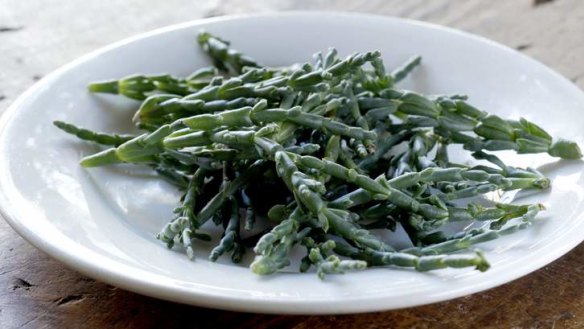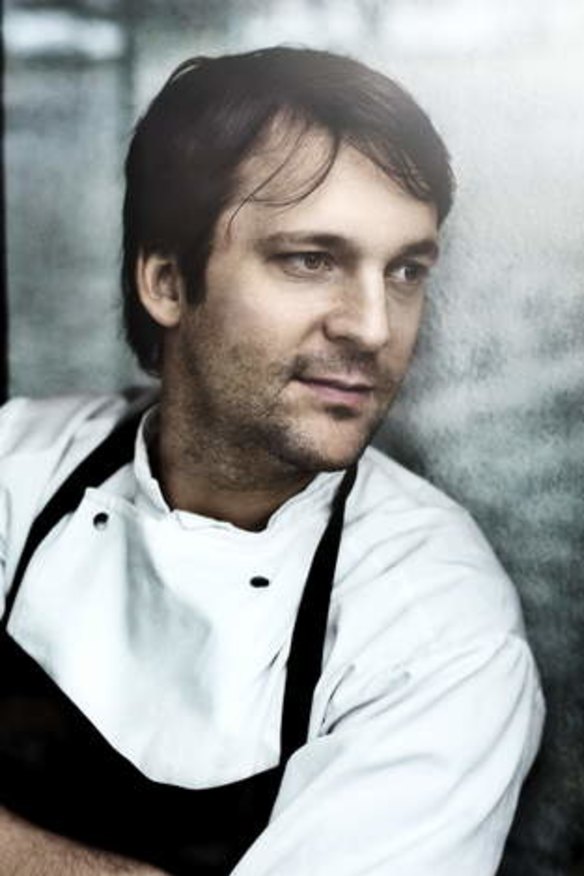Rise of the ant eaters
Spurred on by a culinary leader, Sydney chefs are embracing the new and native.

When Rene Redzepi - one of the most feted chefs in the world - appeared at the Sydney Opera House in October 2010, his talk turned into more of a lecture.
The Danish chef teased the audience about the lack of ''Australianness'' in the food he had eaten on his visit. He found it ''weird'' he hadn't been served kangaroo, and told the story of a local journalist who almost vomited when he suggested eating emu eggs.

As chef at Noma restaurant in Copenhagen, Redzepi has helped make food foraging cool the globe over.
In the audience at the Opera House three years ago, some of the city's leading chefs were listening. It made some of them wonder whether Sydney was being left behind and they questioned the very notion of Australian cuisine.
Then they started putting on their menus new ingredients - truly Australian ingredients, from saltbush to green tree ants - found along our coastlines and in our bushland.
As part of Good Food Month in October, some of our best chefs will regroup with Redzepi to cook a dinner that picks up where his 2010 talk left off. And the conversation about what Australian food is and should be will only become louder.
Kylie Kwong, Billy Kwong
Kylie Kwong is the poster child for native ingredients. She was in the audience for Redzepi's keynote address in 2010.
''I spent the next day, literally, trying to track down where I could source bush foods,'' she recalls.
The ingredient list at Billy Kwong, in Surry Hills, is proof Kwong has stuck hard to the task, with rosella buds, lemon aspen, samphire, saltbush, warrigal greens and quandongs a sample of the dozen-plus natives she now uses.
Each week the restaurant gets through 35 kilograms of wallaby from Flinders Island, served braised or in wallaby sung choi bao, and the same amount of native plants and fruits (''a huge amount for a small place'').
Kwong has pioneered a new cuisine style as a consequence - Australian-Chinese cuisine.
''Offering these native foods has allowed me to offer a truly authentic Australian-Chinese cuisine experience … native ingredients is my way of offering and showing respect and support to our indigenous Australians.''
Kwong picks Old Man saltbush as the ingredient she believes will be most widely consumed. This year she has also become a huge fan of insects. The edible variety. There are four types of insects on her menu at any one time - at the moment there is Cantonese fried rice with roasted mealworms, crushed wood cockroaches (''they taste like dark chocolate and coffee beans'') and a chilli-cricket sauce. And green tree ants, which are served live at the end of the meal.
She is excited by the growth potential of insect consumption in Australia and says her customers are open to trying them - even when they have to squeeze their heads to kill them, as they do with the ants.
She sees insects being available in supermarkets in as soon as five years' time.
''They are a highly sustainable source of protein, and have been eaten in places like China and Mexico for thousands of years.'' Roasted crickets are a favourite: ''Great with a beer.''
Neil Perry, Rockpool
Warrigal greens (a native spinach) keep popping up on the menus at Neil Perry's fleet of restaurants.
''I really like that dark bitterness. We use them in a stir-fry at Spice Temple; they've been on the menu at Rockpool Bar & Grill, and with chicken at Rockpool on George.''
Perry uses a number of native ingredients, such as lemon myrtle and Davidson plum, but has struggled to widen the portfolio.
''I think wallaby is really nice, but we find it so difficult to sell,'' he says. ''I think there's this perception with a lot of people that it's what they used to feed their cats and dogs.''
The chef is toying with serving bar cod with warrigal greens and saltbush or a custard with Sichuan flavours for the dinner.
''People were dabbling with our native ingredients; what Rene's talk did was spark the debate to go wider.''
James Viles, Biota Dining
A couple of afternoons a week the team from Biota Dining heads out into the southern highlands countryside to forage. By the side of the road they pull out wild nettles and wild fennel. In season they go mushrooming in local forests rich in slippery jacks.
''We pulled out about 80 kilos this year,'' says Biota's chef and owner, James Viles.
He uses native ingredients, and lots of them. Saltbush is served with apples, and a beef dish adorned with native pepper berries and potatoes - made to resemble the berries but offering a counter taste.
''Coorong spinach is great. It has a thick leaf; it is almost like a succulent,'' Viles says. ''I think it is really important to learn more about how these things have been used in the past; it gives more integrity to how we use them in the future. A lot of the berries were used as a paint, so why don't we use them as a food colouring rather than [using] something artificial?''
Peter Gilmore, Quay
Peter Gilmore collects exotic produce as a philatelist hoards old stamps. Lined up in his kitchen are some of his current favourites. Tasmanian snowberries, native apples, warrigal greens and native (or sea) parsley.
A confessed produce junkie who contracts farms to grow little-known imported vegetables, Gilmore is just as passionate about protecting native produce.
''My generation grew up in a multicultural environment,'' he says. ''We aren't burdened or confined by the boundaries of an existing cuisine, so there's this sense of freedom, more individuality in our food. An example is a dish we're doing where we turn water chestnuts into a floss. The inspiration of the dish is the outside of a Chinese yum cha dumpling.''
Martin Benn, Sepia
Observing Martin Benn's favourite new ingredient in the wild isn't easy. Carib prawns are caught 450 metres beneath the surface off the coast of Western Australia.
''They are a prawn with a high oil content, much like krill but the size of a shrimp,'' says Benn, chef and co-owner at Sepia restaurant. ''Because of the high oil content it is able to be eaten as sashimi or just lightly poached.''
The Sydney fine diner has plenty of native ingredients pass through its kitchen. Benn uses finger limes, lemon myrtle and blood lime, and will build his dish for the Good Food Month dinner around seafood fished exclusively in Australian waters.
''I was thinking of marron yabbies or even Glacier 51 toothfish,'' he says. ''We are a country very aware of food and where it comes from and I feel with a new generation of young chefs inspired by great chefs, like Rene Redzepi, we are going to create a home-grown, new and interesting cuisine based on our native ingredients.''
Brent Savage, Bentley Restaurant & Bar
While Brent Savage believes the Redzepi lecture fuelled Australians to look in their own backyard for ingredients, he argues for a measured approach rather than wholesale change.
One of Savage's dishes uses wattleseed as a crumb with quail. ''I think the way that it is incorporated into our menu is very subtle, and really is integrated by using a familiar technique,'' he says.
''I don't think it's a single ingredient that influences a restaurant; it's a general philosophy that becomes an influence. At the moment, I see Australian restaurants being influenced by natural, native and organic food … It really is a great platform for this discussion; for me, Australian cuisine is about recognising our native ingredients but also recognising all of our other major food influences. Australia is very unique because we have such a multicultural society … I truly believe our dining scene is as strong as anywhere in the world and I hope in the near future we can become recognised as world leaders and not just amazing interpreters, as we definitely have the talent and knowledge to do it.''
Mark Best, Marque Restaurant
At Marque restaurant in Surry Hills, native hibiscus or rosella flower is used with malted chocolate mousse, saltbush is fried and served with poached oysters, and bower spinach garnishes fish dishes. They are combinations you're unlikely to find in the kitchen of legendary French restaurant L'Arpege, where Marque's owner-chef Mark Best worked.
''Rene's talk was highly influential,'' Best says. ''I think it served to make us look inward at what we had.'' And he believes the ingredients are about to make the leap from niche restaurant ingredient to retail.
''Bower spinach, saltbush, quandongs, native hibiscus could all find themselves on the shelves,'' he says. ''It would be nice to see roo meat being processed with the same degree of care that we are used to with our common domestic animals.''
Best has given much thought to his contribution to the dinner, and is leaning towards basing his dish on a native grain.
''The Aborigines have been collecting and milling grain for thousands of years. Basic breads were produced. We have found a red grain in Mary River that indigenous people of the area have used for 2000 years.''
The hot ingredients — and Kylie Kwong's tips on what to do with them
Saltbush: There is a great salty tang to the leaves, which can be used fresh in a salad or sauteed and stir-fried.
Wallaby: Kwong recommends buying Flinders Island wallaby (''they graze on salt-laden grass'') — the tail can be used exactly as you would use oxtail and slowly braised. Or the tender loin, which can be barbecued or even served carpaccio as Shannon Bennett at Vue de Monde does. ''It is such a tender, delicate, lean and clean meat.''
Crickets: Buy them roasted, then crush them and use them like you would dried shrimp — sprinkled on top of dishes for texture and flavour. Or serve with a beer.
Lemon myrtle: Crush the leaves and combine with ginger to make a tea, or use them as you would bay leaves, in a stock, for example.
Warrigal greens: These plump leaves are great for using in stir-fries or blanched then sauteed with garlic and olive oil.
Samphire: The salty tang of its succulent little stems makes this great with seafood. Blanch and throw into salads, fold into omelets, or serve with fish curries and other fish dishes.
Quandong: A native dessert fruit with a tart flavour can be pickled, made into jam and, because of their tartness, are great with rich dishes such as roasted duck.
Native parsley: Related to European parsley, it has a saltier ''oceanic'' tang and can be chopped and thrown into stir-fries and casseroles at the last minute.
Where you might find them
Edible Bug Shop: www.ediblebugshop.com.au
Australian Gourmet Merchants: Email austgourmetmerchant@bigpond.com forproduct range and stockists
The Essential Ingredient: Rozelle
Wholefoods House: Woollahra and Waterloo
B.U Organics: Bondi
Vic Cherikoff: www.cherikoff.net
Restaurant reviews, news and the hottest openings served to your inbox.
Sign up- More:
- Restaurant news
